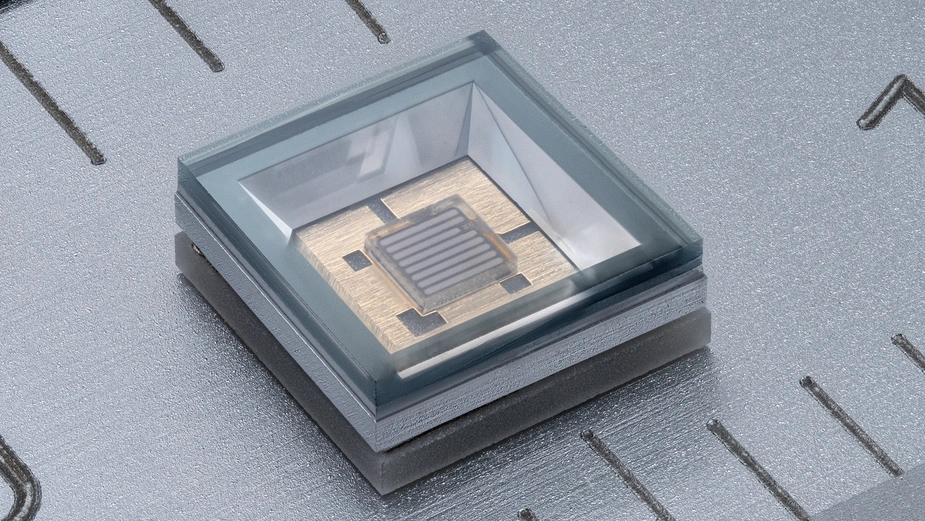FBH showcases latest R&D results at Photonics Days
Conference focusing on laser technology, microsystems technology and quantum technologies on 8 and 9 October in Adlershof
For two days, experts from research and industry will meet in Berlin-Adlershof to exchange views on the latest trends in laser technology, heterogeneous integration, microsystems technology, and more. Once again, quantum technologies will take center stage on October 8 and 9. Prof. Tim Schröder, Prof. Markus Krutzik, and Dr. Sven Ramelow – each of whom heads a Joint Lab of FBH with Humboldt-Universität zu Berlin (HU Berlin) – are chairing four quantum symposia (Q-Imaging, Q-Communication, Q-Computing, and Q-Sensing). They are supported by Dr. Tommaso Pregnolato (FBH) and Dr. Gregor Pieplow (HU Berlin). The symposia aim to provide an overview of current trends and developments and to build bridges between cutting-edge research and industrial applications. Quantum technologies and laser modules for space applications will also be featured during a guided laboratory tour at FBH, part of the conference’s supporting program.
UVC LEDs for medical applications and gas sensing
This year, FBH is also placing special emphasis on ultraviolet light-emitting diodes (UV LEDs). Dr. Sven Einfeldt, head of the Joint Lab GaN Optoelectronics at FBH, is one of the chairs of the session “UV & X-Ray Technologies & Applications.” In this context, Dr. Jan Ruschel will present recent technological advances in UVC LEDs. The institute has succeeded in significantly improving the efficiency, lifetime, and performance of LEDs emitting in the far-UVC range below 235 nanometers (nm). These advances open up new applications in medicine and gas sensing. For example, harmful microorganisms, including multidrug-resistant pathogens (MDR), can be killed without the risk of resistance development. Because light at these wavelengths is strongly absorbed, it penetrates only minimally into the living layers of skin, enabling effective disinfection without causing damage beyond that of normal sun exposure.
Further details on this technology and its applications were published in a July 2025 press release.
Company Pitch: miniaturized far-UVC diode laser module for disinfection
UVC radiation for medical use is also the focus of the “UV-COLA” project, which Susann-Alice Seeger will present in her company pitch. This spectral range can be accessed using both LEDs (see above) and diode lasers. In the approach pursued jointly by FBH and University of Technology Chemnitz, violet-emitting semiconductor lasers provide the basis. In a MOPA configuration, brilliant, high-power radiation is generated and frequency-doubled into the UVC range using a nonlinear crystal. Coupled into a thin fiber, this radiation could be applied directly to disinfect the nose and throat area – a major reservoir for multidrug-resistant germs, from which they can spread or cause severe infections.
Gallium arsenide-based photonic integration
Many applications in quantum physics, spectroscopy, or biosensing rely on lasers that emit at wavelengths between 630 nm and 1180 nm. This spectral range can be addressed with the semiconductor material gallium arsenide (GaAs). In his talk in the session “Advances in hybrid PICs based on PolyBoard and SiN for communications, sensing and quantum technologies Part II,” Dr. Jan-Philipp Koester will discuss the integration of GaAs chiplets onto low-loss, passive silicon nitride photonic integrated circuits (PICs) using micro-transfer printing.
At its booth, FBH will also present a monolithic GaAs-based photonic integrated waveguide platform with on-chip amplification and both shallow- and deep-etched passive waveguides. This platform forms the basis for ring-resonator-coupled lasers and is suitable for the 950 nm to 1180 nm wavelength range.
Contact:
Petra Immerz, M.A.
Communications Manager
Ferdinand-Braun-Institut gGmbH, Leibniz-Institut für Höchstfrequenztechnik
Gustav-Kirchhoff-Straße 4, 12489 Berlin
+49 30 6392-2626
petra.immerz(at)fbh-berlin.de
www.fbh-berlin.de
FBH press release, 30.09.2025
